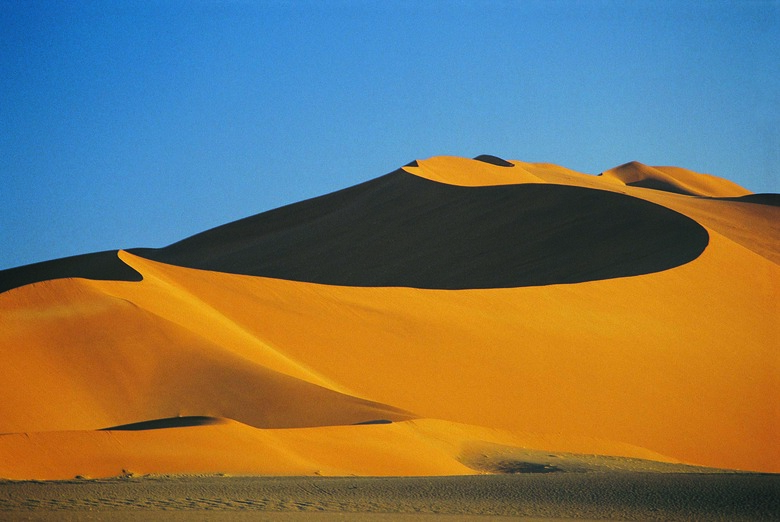The Driest Places On Earth With The Least Rain
Both hot and cold deserts have areas of low rainfall. The driest desert areas fall into the hyperarid category, which encompasses 4.2% of the world's total land area. Rainfall in hyperarid regions seldom is over 100 mm (four inches) per year, is irregular, and sometimes doesn't fall for several years. Reasons for aridity include distance from oceanic sources of moisture, isolation from weather-making storm systems, and geographic features such as high mountain ranges or cold offshore ocean currents that harvest moisture from the air.
The Dry Valleys of Antarctica
The Dry Valleys of Antarctica
The firmest candidate for the driest place on Earth is an especially harsh spot on the driest (and coldest) continent of all: Antarctica, a true polar desert. Antarctica gets most of its precipitation as snow, with an equivalent of about 150 mm (six inches) of water annually. Over the center of the land mass, less than 50 mm (1.9 inches) of snowfall occurs.
The McMurdo Dry Valleys in eastern Antarctica are barren lands that essentially receive no precipitation whatsoever and may not have for millions of years, and unlike the rest of the continent are mostly ice free. The surrounding Transantarctic Mountains are the primary cause of these hyperarid areas. They block the East Antarctic Ice Sheet from overrunning the valleys, and also help funnel powerful drying winds – called katabatic winds – which evaporate moisture as they sweep downslope.
Atacama Desert
Atacama Desert
The driest area on Earth outside Antarctica is within the Atacama Desert of Peru and Chile. This coastal desert is 600 miles long, stretching from the Pacific ocean inland to the pampas grasslands and the dry highland altiplano. Areas of absolute desert in the center of the Atacama are entirely without recorded rainfall, at least during the time humans have been recording it.
Annual precipitation in the Atacama Desert is ten mm (0.04 inches), mostly from fog. Rainfall occurs two to four times a century. Frequent fogs keep the temperatures relatively cool, averaging about 18 degrees Celsius (65 degrees Fahrenheit), and results in high relative humidity of about 75%. Large areas are without vegetation of any kind.
African Deserts
African Deserts
The Sahara Desert of northern Africa is the largest hot desert in the world. This hot desert has recorded a high temperature of 58 degrees Celsius (136.4 degrees Fahrenheit) at Al-Aziziya, Libya. Rainfall averages about ten centimeters (four inches) annually, with many areas receiving less, sometimes none for 100 years or more. Many areas have little to sparse vegetation.
A second very dry African desert, the Namib, exists along the coast of western Namibia. Rainfall varies from an average of five mm (0.19 inches) in the west to about 85 mm (3.3 inches) in the east. Fog is also common in the Namib.
Rub al-Khali
Rub al-Khali
Called the Empty Quarter, the Rub al-Khali Desert of Arabia is the largest sand desert in the world. Most of it has an average annual rainfall below 50 mm (two inches), but an area in the south of this desert has a mean annual rainfall of less than 16 mm (0.6 inches). The Rub al-Khali falls within the Arabian Desert that covers almost all of Saudi Arabia and extends into nearby Middle Eastern countries. Rainfall in the Arabian Desert is usually less than 100 mm (four inches) a year.
Other Notable Super-Dry Places
Other Notable Super-Dry Places
Cold winter deserts of central Asia include the Gobi Desert of China and Mongolia, which averages about 178 mm (seven inches) of rain yearly. Central areas receive about 25 to 50 mm (one to two inches) of rain annually. China's Taklamakan Desert has an average of about 20 mm (0.78 inches) annually in its center, with 50 mm (two inches) occurring along the edges.
The driest parts of North America lie in the hot deserts of the Mojave and the Sonoran in the southwestern United States and northern Mexico. California's Death Valley in the Mojave is often called the driest site on the continent. This lowest and hottest area in North America receives less than five cm (two inches) of annual rainfall on average, has experienced entire rainless years, and during its driest recorded period saw a mere 1.6 cm (0.64 inches) of precipitation over 40 months between 1931 and 1934. Parts of the Sonoran Desert's Lower Colorado Valley subsection may rival Death Valley in the dryness department, with some sites having endured 36 rainless months at a stretch.
References
- University of Nevada Las Vegas: Causes of Aridity, and Geography of the World's Deserts
- United Nations Food and Agriculture Organization: The Arid Environments
- World Wildlife Fund: Africa: Namibia
- Australian Antarctic Program: Antarctic Weather
- Encyclopaedia Iranica: Taklamakan
- U.S. National Park Service: Weather and Climate – Death Valley National Park
- Arizona-Sonora Desert Museum: Natural History Info
- Exploratorium: Ice Stories – Dry Valleys
- Live Science: Antarctic Hills Haven't Seen Water in 14 Million Years
Cite This Article
MLA
Csanyi, Carolyn. "The Driest Places On Earth With The Least Rain" sciencing.com, https://www.sciencing.com/driest-places-earth-least-rain-21919/. 30 September 2021.
APA
Csanyi, Carolyn. (2021, September 30). The Driest Places On Earth With The Least Rain. sciencing.com. Retrieved from https://www.sciencing.com/driest-places-earth-least-rain-21919/
Chicago
Csanyi, Carolyn. The Driest Places On Earth With The Least Rain last modified March 24, 2022. https://www.sciencing.com/driest-places-earth-least-rain-21919/
